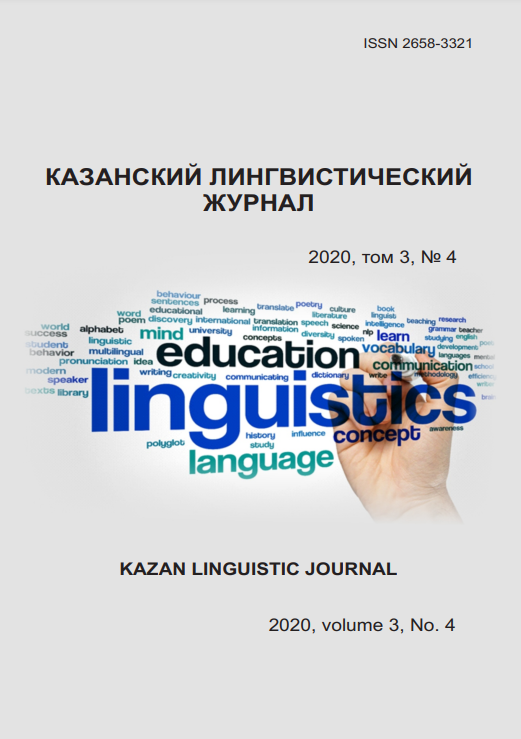Mitigative specific of verb replication in chinese language (on the example of the tv-series “we are together”)
Keywords:
reduplication, mitigation, pragmatics, communication, adaptation, Chinese, media discourseAbstract
This study examines one of the important functions of the Chinese verb reduplication – mitigation or communicative mitigation. It should be noted that Russian sinologists underestimate this phenomenon and only give a general description of reduplication as a speech mitigation strategy. In this regard, in addition to the lexical, grammatical and syntactic properties of verb doubling in Chinese, we separately considered speech situations with verb reduplication and determined what specific communication tasks this category of language solves. Among other things, in this work, we make an attempt, through translation analysis, to determine which lexical and grammatical means of expression of mitigation through verb doubling are equivalent to Chinese in Russian and why. We took examples from media discourse as linguistic material. In the course of our work, we used the historical, comparative-comparative method and translation analysis of the Chinese text.
In the course of the study, we came to the following conclusions: in comparison with the infinitive form, the doubled form of the verb has a pronounced, distinct softening function, which is most clearly manifested in such communicative situations as persuasion, face protection, consolation and demonstration of politeness. The reduplicated form of the verb is a strategy that communication participants use for language adaptation in a particular communication situation. Its key goal is to reduce the psychological, social and emotional "distance" between individuals, to reduce or minimize the psychological burden on the interlocutor, while increasing the degree of trust, which, in general, is aimed at improving the quality of interpersonal relationships.
References
Литература
Маслова В.А. Современная лингвистика - наука о человеке, его сознании, языке и культуре // Гуманитарный вектор. 2018. №1. // URL: https://cyberleninka.ru/article/n/sovremennaya-lingvistika-nauka-o-cheloveke-ego-soznanii-yazyke-i-kulture (дата обращения: 11.11.2020).
Минакова А.А. Типы и функции повторов в поэтических текстах Евгения Евтушенко: автореф. дис. … канд. филол. наук: Майкоп, 2012. 22 c.
Рахимбекова Л.Ш. Повторы и их функции в современном китайском языке: автореф. дис. … канд. филол. наук: Москва, 2000. 23 c.
Саньярова Н.С. Редупликация в системе разноуровневых средств повтора в русском языке // Научно-методический электронный журнал «Концепт», 2018. // URL: https://cyberleninka.ru/article/n/reduplikatsiya-v-sisteme-raznourovnevyh-sredstv-povtora-v-russkom-yazyke/viewer (дата обращения: 10.11.2020).
Тахтарова С.С. Категория коммуникативного смягчения: когнитивно-дискурсивный и этнокультурный аспекты: монография. Волгоград: Изд-во ВолГУ, 2009. 382 с.
Тахтарова С.С. Функциональная прагматика средств выражения «Смягчения» // Известия Самарского научного центра РАН. 2008. №6¬2. // URL: https://cyberleninka.ru/article/n/funktsionalnaya-pragmatika-sredstv-vyrazheniya-smyagcheniya (дата обращения: 08.11.2020).
Толковый словарь Ожегова он-лайн // URL: ozhegov.dicti.info (дата обращения: 30.10.2020)
Труханова Д.С. Митигативный потенциал обращения в институциональном политическом дискурсе // Филологические науки. Вопросы теории и практики. 2019. №11. // URL: https://cyberleninka.ru/article/n/mitigativnyy-potentsial-obrascheniya-v-institutsionalnom-politicheskom-diskurse (дата обращения: 09.11.2020).
Caffi C. On Mitigation. Journal of Pragmatics, 1991. Pp. 881–909.
Fraser B. Conversational mitigation. Journal of Pragmatics, 1980. Pp.342–350.
Malinowski B. The problem of meaning in primitive languages. Ogden & I. A. Richards. The meaning of meaning. London: Routledge and Kegan Paul, 1930. Pp. 296–336.
Skewis M. Mitigated directness in Honglou Meng: Directive speech acts and politeness in eighteenth century Chinese. Journal of Pragmatics, 2003. Pp. 161–189.
Verschueren J. Understanding Pragmatics. Beijing: Foreign Language Teaching and Research Press, 2000. Pp. 55–56.
毛延生. 汉语中语用缓和策略的市政研究. 南京理工大学学报,2011. 74–84页.
冉永平. 言语交际中“吧”的语用功能及其语境顺应性特征, 现代外语, 2004. 340–349页.
冉永平, 张新红. 语用学纵横, 高等教育出版社, 2007. 124页.
宛新政. “( N) 不 V”祈使句的柔劝功能. 世界汉语教学, 2008. 16–27页.
现代汉语词典( 增补本) . 北京: 商务印书馆, 2000. 1767 页.
徐阳春. 汉语动词重叠式的语用考察. 南昌大学学报, 2007. 135–137页.
张爱民, 杜娟. 动词重叠与句法的语用制约. 徐州师范大学学报,2005. 63–66页.
张宏武.汉语动词重叠式的语用缓和功能. 长春师范大学学报, 2017.6页.
朱景松. 动词重叠式的语法意义. 中国语文, 1998. 378–386页.
References
Maslova V.A. (2018). Modern linguistics is the science of man, his consciousness, language and culture. Scientific and methodical electronic journal “Gumanitarnyi vektor”. // URL: https://cyberleninka.ru/article/n/sovremennaya-lingvistika-nauka-o-cheloveke-ego-soznanii-yazyke-i-kulture (accessed: 11.11.2020). (In Russian)
Minakova A. A. (2012). Types and functions of repetitions in poetic texts by Evgeny Yevtushenko. Cand. philos. sci. diss. 22 p. Maykop. (In Russian)
Rakhimbekova L. Sh. (2000). Repetitions and their functions in modern Chinese. Cand. philos. sci. diss. 23 p. Moscow. (In Russian)
Saniarova N.S. (2018). Reduplication in the system of multilevel repetition tools in Russian. Scientific and methodical electronic journal “Kontsept”. // URL: https://cyberleninka.ru/article/n/reduplikatsiya-v-sisteme-raznourovnevyh-sredstv-povtora-v-russkom-yazyke/viewer (accessed: 10.11.2020). (In Russian)
Tahtarova S.S. (2010). Category of communicative mitigation: cognitive-discursive and ethnocultural aspects. Doct. philol. sci. diss. 40p. Volgograd (In Russian)
Tahtarova S.S. (2008). Functional pragmatics of the means of expression “Mitigation”. Izvestiya Samarskogo nauchnogo tsentra RAN. // URL: https://cyberleninka.ru/article/n/funktsionalnaya-pragmatika-sredstv-vyrazheniya-smyagcheniya (accessed: 08.11.2020). (In Russian)
Explanatory dictionary Ozhegov on-line // URL: ozhegov.dicti.info (accessed: 30.10.2020) (In Russian)
Trukhanova D.S. (2019). Mitigative potential of circulation in institutional political discourse. Scientific and methodical electronic journal “Filologicheskiye nauki. Voprosy teorii i praktiki”. // URL: https://cyberleninka.ru/article/n/mitigativnyy-potentsial-obrascheniya-v-institutsionalnom-politicheskom-diskurse (accessed: 09.11.2020).
Caffi C. (1991). On Mitigation. Journal of Pragmatics. Pp.881–909. (In English)
Fraser B. (1980). Conversational mitigation. Journal of Pragmatics. Pp. 342 350. (In English)
Malinowski B. (1930). The problem of meaning in primitive languages. Ogden & I.A. Richards. The meaning of meaning. London: Routledge and Kegan Paul. Pp. 296¬336. (In English)
Skewis M. (2003). Mitigated directness in Honglou Meng: Directive speech acts and politeness in eighteenth century Chinese.
Journal of Pragmatics. Pp. 161–189. (In English)
Verschueren J. (2000). Understanding Pragmatics. Beijing: Foreign Language Teaching and Research Press. Pp. 55–56. (In English)
毛延生. (2011). 汉语中语用缓和策略的市政研究. 74–84页.南京理工大学学报. (In Chinese)
冉永平. (2004). 言语交际中“吧”的语用功能及其语境顺应性特征. 340–349页. 现代外语. (In Chinese)
冉永平, 张新红. (2007). 语用学纵横. 124页.高等教育出版社. (In Chinese)
宛新政. (2008). “(N) 不 V”祈使句的柔劝功能. 16–27页. 世界汉语教学. (In Chinese)
现代汉语词典( 增补本) . (2000). 1767 页.北京: 商务印书馆. (In Chinese)
徐阳春.(2007). 汉语动词重叠式的语用考察. 135 -137页.南昌大学学报. (In Chinese)
张爱民, 杜娟. (2005). 动词重叠与句法的语用制约. 63–66页.徐州师范大学学报. (In Chinese)
张宏武. (2017). 汉语动词重叠式的语用缓和功能.6页.长春师范大学学报. (In Chinese)
朱景松. (1998). 动词重叠式的语法意义. 378–386页.中国语文. (In Chinese)






